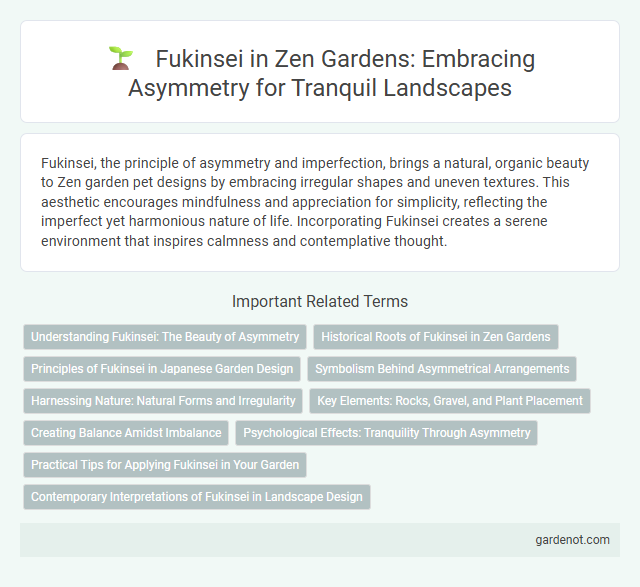Fukinsei, the principle of asymmetry and imperfection, brings a natural, organic beauty to Zen garden pet designs by embracing irregular shapes and uneven textures. This aesthetic encourages mindfulness and appreciation for simplicity, reflecting the imperfect yet harmonious nature of life. Incorporating Fukinsei creates a serene environment that inspires calmness and contemplative thought.
Understanding Fukinsei: The Beauty of Asymmetry
Fukinsei, a core principle in Zen gardens, emphasizes the beauty found in asymmetry and imperfection, creating a balanced yet dynamic aesthetic that evokes natural spontaneity. This concept challenges traditional notions of symmetry by celebrating irregularity and imbalance, reflecting the transient nature of life. Through careful placement of rocks, plants, and pathways, Fukinsei fosters a serene environment that encourages mindfulness and contemplation.
Historical Roots of Fukinsei in Zen Gardens
Fukinsei, the principle of asymmetry and imperfection, traces its origins to ancient Japanese aesthetics influenced by Zen Buddhist philosophy during the Muromachi period (1336-1573). Zen gardens such as Ryoan-ji in Kyoto exemplify Fukinsei through intentionally uneven rock placements and asymmetrical layouts designed to inspire contemplation and reflect the impermanence of life. This concept contrasts with classical Western garden symmetry, emphasizing natural spontaneity and spiritual depth rooted in Zen teachings.
Principles of Fukinsei in Japanese Garden Design
Fukinsei, a core principle in Japanese garden design, emphasizes asymmetry and imbalance to evoke natural beauty and dynamic tension. It challenges traditional symmetry by incorporating irregular shapes, uneven textures, and varied elements that create a sense of natural spontaneity. This deliberate imperfection reflects the transient nature of life and encourages mindful contemplation within the Zen garden.
Symbolism Behind Asymmetrical Arrangements
Fukinsei embodies the principle of asymmetry, symbolizing the beauty found in imperfection and natural imbalance within Zen gardens. This deliberate arrangement encourages contemplation of life's inherent unpredictability and the acceptance of impermanence. By breaking away from rigid symmetry, Fukinsei reflects the dynamic, ever-changing nature of existence, fostering a deeper spiritual connection.
Harnessing Nature: Natural Forms and Irregularity
Fukinsei, a key principle in Zen gardens, emphasizes the beauty of asymmetry and irregularity to reflect nature's imperfect forms. By incorporating uneven rocks, asymmetrical plant arrangements, and varied textures, the design mimics the spontaneous and unpredictable patterns found in the natural world. This deliberate imbalance creates a dynamic harmony that encourages contemplation and a deeper connection with nature's inherent unpredictability.
Key Elements: Rocks, Gravel, and Plant Placement
Fukinsei in a Zen garden emphasizes asymmetry and natural balance through the strategic placement of rocks, gravel, and plants. Rocks are positioned unevenly to evoke natural landscapes, while gravel is carefully raked in irregular patterns to symbolize water flow and impermanence. Plant placement avoids symmetry, featuring varied heights and textures to enhance the sense of organic harmony and contemplative space.
Creating Balance Amidst Imbalance
Fukinsei embodies the Japanese aesthetic principle of asymmetry, emphasizing the beauty found in imperfection and irregularity within a Zen garden. This balance amidst imbalance invites mindful contemplation, as uneven rocks, varied plant placements, and winding paths harmonize to evoke natural spontaneity. Through deliberate asymmetry, Fukinsei enhances the garden's spiritual depth, reflecting life's inherent unpredictability and fostering inner tranquility.
Psychological Effects: Tranquility Through Asymmetry
Fukinsei, the principle of asymmetry in Zen gardens, fosters psychological tranquility by breaking the expectation of perfect balance, encouraging a mindful appreciation of imperfection. This asymmetry cultivates a meditative state, reducing stress and enhancing emotional resilience by inviting observers to embrace natural irregularities. The deliberate imbalance in rock placement and plant arrangement stimulates a calming awareness, promoting inner peace and mental clarity.
Practical Tips for Applying Fukinsei in Your Garden
Incorporate Fukinsei in your Zen garden by arranging rocks and plants asymmetrically to create visual interest and natural flow. Use uneven spacing and varied textures to evoke a sense of imperfection and spontaneity, emphasizing balance through contrast rather than symmetry. Select elements that highlight natural irregularities, such as weathered stones or twisted branches, to enhance the garden's dynamic and contemplative atmosphere.
Contemporary Interpretations of Fukinsei in Landscape Design
Contemporary interpretations of Fukinsei in landscape design emphasize asymmetry and natural imperfection to create dynamic, engaging spaces that evoke harmony through imbalance. Designers integrate irregular rock placements, varied plant heights, and uneven pathways to reflect organic forms and unpredictability, challenging traditional notions of symmetry and order. This approach enhances the spiritual and aesthetic qualities of Zen gardens, inviting deeper contemplation and interaction with natural elements.
Fukinsei Infographic

 gardenot.com
gardenot.com